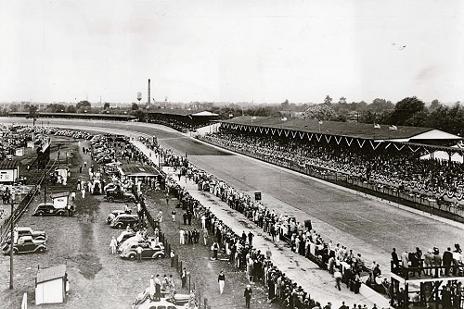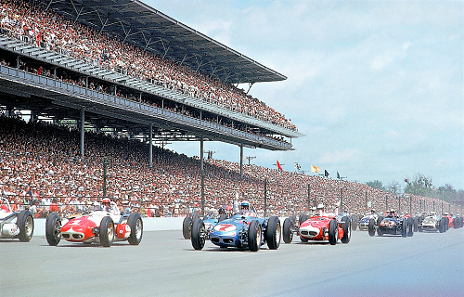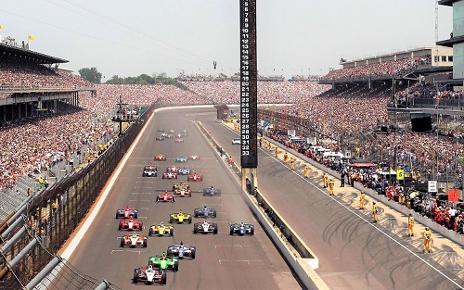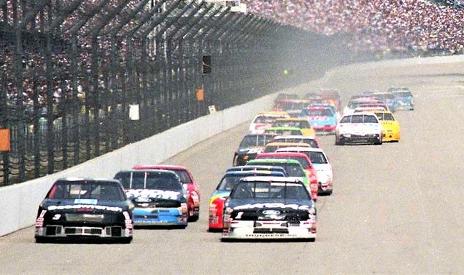INDIANAPOLIS MOTOR SPEEDWAY - SPEEDWAY IN

bricks for race surface
a LOT of history about Indy - probably the oldest race track in the nation; and known world wide. The track is a 2 1/2 mile paved oval. Beginning in 1909; there was 3.2 million bricks were brought in to create the racing surface; thus the age old name, "the brick yard". It is the second purpose-built, banked oval racing circuit in the world. The first one in the U.S. and the first to be a 'speedway'. It has a permanent seating capacity of over 250,000 and when you include the infield area it can hold over 400,000 spectators. The largest sports venue in the world. 1911 saw 80,000 spectators came to see the first ever Indy 500. It was won by Ray Harroun. All the other cars had a riding mechanic to help 'spot' for the driver. Harroun did away with the extra person and installed a mirror. The first ever rear-view mirror in any automobile. Louis Meyer became
the first three time winner in the Indy 500 in 1936. After his win in 1933 he started the tradition of drinking a bottle of milk in victory lane. In 1940 Wilbur Shaw became the second three time winner. The track saw no activity and the races were canceled from 1942-1945 due to World War II. The track fell into a state of disrepair. Like in today's times; many locals believed that the track should be demolished and turned into a housing development. Wilbur Shaw returned from the war to do a 500 mile tire test for Firestone, and found out the track was for sale. Shaw contacted Terre Haute businessman Tony Hulman who purchased the speedway in late 1945. Major renovations and repairs were made at a quick pace to the frail speedway, in time for the 1946 race. Since then, the speedway has continued to grow. Stands have been built and remodeled many times over, suites and museums were

pre-race 1940

the rear engine roadster era - pic from 1962
added, and many other additions helped bring back Indy's reputation as a great track. In the 1950s, cars were topping out at 150 mph, helping to draw more and more fans. The low-slung, sleek cars were known as roadsters. In October 1961, the final remaining brick sections of the track were paved over with asphalt, with the exception of a distinct three-foot-wide line of bricks at the start-finish line. The "Brickyard" thus became known for its "Yard of Bricks". AJ Foyt, who had won his first 500 in 1961, won the 1964 Indianapolis 500, which was the last ever win for a front-engine car. Since Jim Clark's win driving the rear-engine Lotus 38 in 1965, every winner has driven a rear-engine car. Foyt would go on to become the third three time winner in 1967. It took an additional ten years, but Foyt would become the races first ever four time winner in
1977. Also, in 1977 Janet Guthrie would become the first woman to ever compete in the Indy 500. She competed in the race on three occasions before moving to race in the NASCAR Series. She had a best finish of ninth in the 1978 500. School teacher turned race driver Tom Sneva became the first driver to have a qualifying lap over 200 mph in 1977. As we entered the 1980's and year thereafter the track saw the search for speed ever increasing. Sneva broke the 210 mph mark in 1984 as his one lap average of 210.689 sat a new one lap average. He also posted the four lap average at 210.029. Sneva finished second in the race in 1977, 1978, and 1980. Finally, he broke through for the 500 victory in 1983 by out-dueling Roger Penske driver Al Unser Jr. It was sweet revenge for Sneva who had been


First NASCAR race at Indy - 1994
fired by Penske at the end of the previous season; even though he had won back to back Indy Championships. Speeds increased over the years to where currently (2022) the one lap qualifying record is an astounding 237.498 while the four lap mark stands at 236.986. The fastest race lap is 236.103. All the records were set in 1996. With speed on the rise at a rapid pace; Indy car officials stepped in to decrease downforce and increase drag to slow the cars down. The fastest race was held in 2013, and won by Tony Kanaan at 187 mph. 2009 marked the 100th Anniversary for the Indy 500. The race was won by Helio Castronevez. Danica Patrick finished; led laps and finished third in the race; the best finish to date for a woman. Speaking of Castronevez, he won in 2021 becoming a four time winner. He joined Rick Mears and Al Unser (and Foyt)
as the only four time Indy 500 winners. NASCAR raced at the speedway for the first time in 1994. Many 'purist' protested the heavy stock cars racing at the track; stating there should be only Indy car races there. However, on race day 350,000 people showed up to watch "The Brickyard 400", won by Jeff Gordon. He edged Brett Bodine by 1/2 second. Dale Earnhardt won the second race, before Dale Jarret and started the tradition of "kissing the bricks" in 1996. NASCAR skipped the race on the Oval track, and run the Road Course in 2021. They will run the road course again and 2022; but it hasn't been determined which layout will be used beyond that point. As of 2022, Jeff Gordon has accumulated the most checkered flags (5); while team mate Jimmie Johnson has four. Gordon is the first five time winner in the tracks history. More on that below.
All Photos copyright and are property of their respective owners
